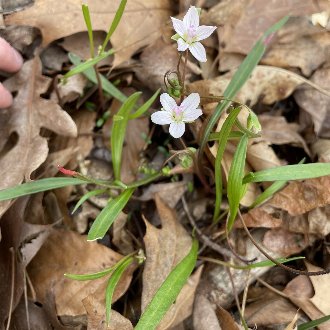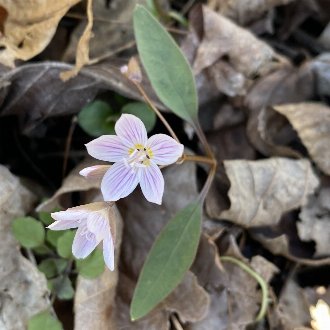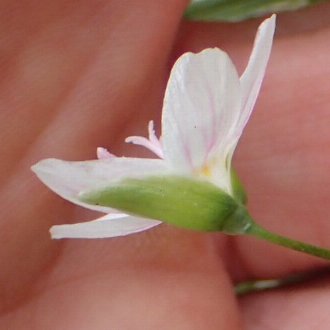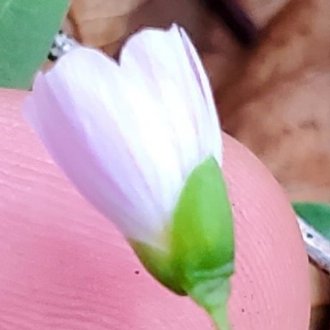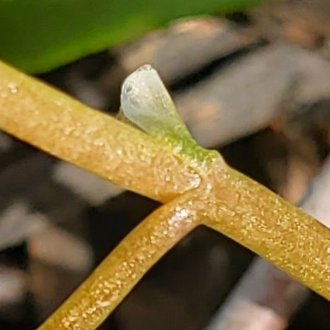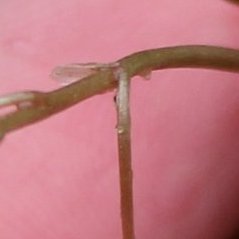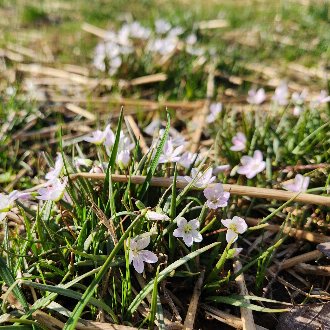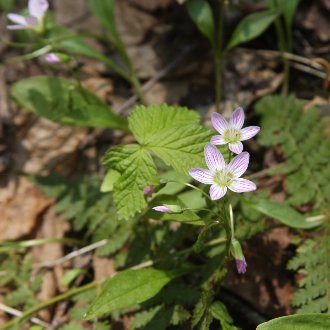Narrow-leaved Spring Beauty vs Northern Spring Beauty
These two native spring ephemerals are visually similar and easily confused where their ranges overlap. They are easily told apart by leaf shape, and there are some other subtle differences which are less reliable for identification. C. virginica ranges much farther south and west, and ranges farther into sunnier and more upland habitats, whereas C. caroliniana ranges farther north, to higher elevations in the Southern Appalachians, and prefers shadier habitats.
Narrow-leaved Spring Beauty (Claytonia virginica) | Northern Spring Beauty (Claytonia caroliniana) |
A common spring ephemeral native to the eastern US and Canada, with small flowers and narrow leaves. | A small spring ephemeral mostly native to the northeastern US and eastern Canada. |
Leaves are narrow (0.2-1.2cm) and taper to a narrow base. Photo © Jonathan Sowers, CC BY 4.0. | Leaves are broader (0.4-2.5 cm) and base of leaf blade is more abrupt and well-defined. Photo © Mark Eanes, CC BY 4.0. |
Sepals (two green structures enclosing the base of each flower) are longer (5-7mm) and tend to look larger relative to the flowers. Photo © George Williams, CC BY 4.0. | Sepals are shorter (3-5mm) and tend to look smaller relative to the flowers. Photo © Will Kuhn, CC BY 4.0. |
Bract (leaflike structure) enclosing the lowest flower stalk tends to be more sturdy. Photo © , CC BY-SA 4.0. | Bract enclosing the lowest flower stalk tends to be rather flimsy. Photo © Steven Lamonde, CC BY 4.0. |
Although it frequently occurs in forests and bottomlands, it also ranges into sunnier, drier, and more upland habitats. It is common in lawns. Photo © Dominic, CC BY 4.0. | Relatively less likely to occur in lawns, and more restricted to forests and bottomlands. Photo © Nick Kleinschmidt, CC BY 4.0. |
Additional Notes
The narrower leaf shape of C. virginica reduces water loss and allows it to range farther into drier and sunnier habitats, whereas the broader leaf shape of C. caroliniana affords it greater shade-tolerance which reflects not only its habitat but its more northerly range, where less solar radiation is available. In the Southern Appalachians, C. caroliniana is found at higher elevations and in cooler, richer forests in sheltered coves, where the ecosystems resemble northern hardwood forests.References & External Resources
These short lists show only links helpful for ID. For a complete list of references and resources also covering other aspects of ecology, visit the links section of the full article on each plant, which is the first entry here.



